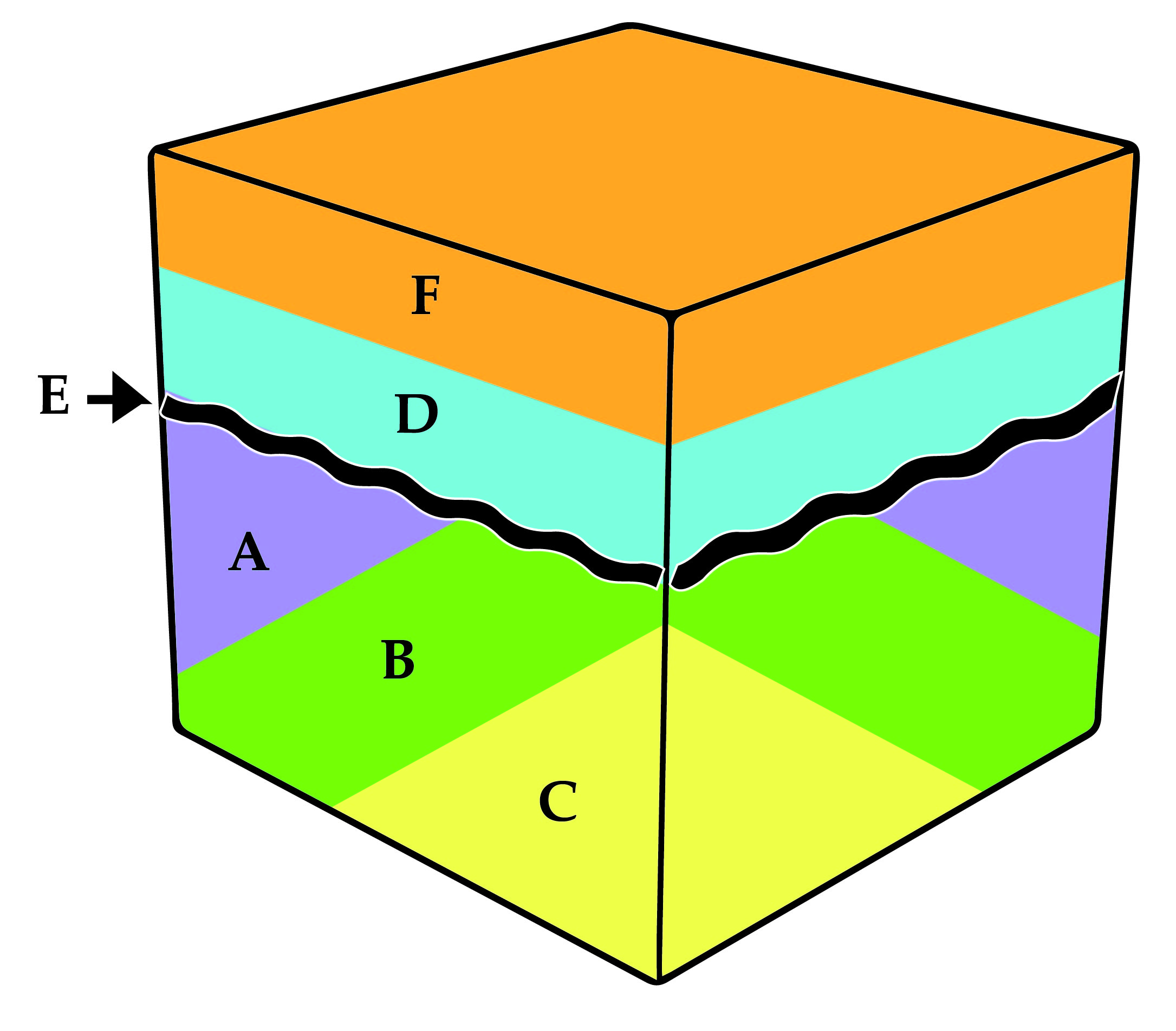All AP Environmental Science Resources
Example Questions
Example Question #1 : Soil And Geology
Geological time scales are used to measure spans of time. In terms of geological time scales, which category represents the smallest length of time?
Era
Supereon
Eon
Period
Period
The correct response is period. This would be the smallest measurement of time given the answer choices.
The order from longest to shortest is shown here: Supereon > Eon > Era > Period
Example Question #2 : Soil And Geology
Geological time scales are used to measure spans of time. In terms of geological time scales, which category represents the longest length of time?
Era
Age
Period
Epoch
Era
The correct response is era because it represents longer periods of time on the geological time scale. The answer choicest from longest to shortest are as follows: Era > Period > Epoch > Age.
Example Question #1 : Soil And Geology

Examine the given block diagram. Each letter represents a depositional event or a period of erosion. Place the letters in order from the oldest to youngest event.
E, C, B, A, D, F
C, B, A, E, D, F
C, B, A, D, F, E
E, F, D, A, B, C
F, D, E, A, B, C
C, B, A, E, D, F
The law of superposition states that the oldest rock layers are at the bottom. A real world example of this often takes place while cooking. When making a seven-layer dip, for instance, you place the oldest layer on the bottom of the dish and stack layers on top. The layer on top is the youngest. The earth is made of rock layers deposited in a similar way.
E represents a period of erosion, meaning there is "missing time" (rock layers have been eroded, so there are no rocks representing that time).

Example Question #2 : Soil And Geology
Which of the following rock types is a result of the rapid cooling of magma?
Igneous
Metamorphic
Fossilized
Oceanic
Sedimentary
Igneous
The three main rock types are sedimentary, igneous, and metamorphic. Sedimentary rock is the result of the build up of sediment, such as sand or dirt. Igneous rocks are the result of the cooling of lava and molten rock, and can be crystalline in structure. Metamorphic rock is the compression of igneous and/or sedimentary rock, creating a new type of rock from intense pressure. Metamorphic rock comprises the majority of the Earth's crust.
Example Question #75 : Introductory Concepts And Earth Science
A scientist is examining two pebbles of a similar composition lying next to each other in a stream. One has a smooth, polished texture, while the other is angular with sharp edges. The differences in surface texture can indicate which of the following regarding the distance each pebble has traveled?
The round pebble has traveled a farther distance and the angular pebble has traveled a short distance
The angular pebble has traveled a farther distance and the round pebble has traveled a short distance.
None of these
Both pebbles are from far away but come from different parent rocks
The round pebble has traveled a farther distance and the angular pebble has traveled a short distance
As rocks travel further from the original outcrop, bumps and abrasions round corners and polish the rock.
Example Question #3 : Rock Cycle
Which of the following factors can cause a sedimentary rock to change into a metamorphic rock?
Increasing temperature
Increasing pressure
All of these
Addition of fluids
All of these
Increasing temperature and pressure—through burial or submersion—causes the minerals that compose the rock to become unstable. This results in recrystallization of the minerals, which forms a new rock.
Example Question #2 : Soil And Geology
A sedimentary rock is buried deep within the earth. At a certain depth, the rock melts completely and recrystallizes. Which of the following best identifies what type of rock is formed post recrystallization?
Metamorphic
Sedimentary
Igneous
Conglomerate
Igneous
The question indicated that the rock melted completely. When a partially melted rock recrystallizes, it becomes a metamorphic rock; however, when a rock completely melts and any crystallization occurs, it results in the production of an igneous rock.
Example Question #1 : Rock Cycle
Which of the following best explains the difference between weathering and erosion?
Weathering is the physical process that creates sediment, while erosion is the chemical process of creating sediment
Weathering is the chemical process that creates sediment, while erosion is the physical process of creating sediment
Erosion is the process that creates sediment, while weathering is the process of transporting sediment
Weathering is the process that creates sediment, while erosion is the process of transporting sediment
Weathering is the process that creates sediment, while erosion is the process of transporting sediment
Weathering is a process that creates sediment. There are physical and chemical weathering processes. On the other hand, erosion is described as a process that transports sediment. Erosion transports sediment through exogenous processes, such as by water or wind.
Example Question #3 : Soil And Geology
In the desert, a rock can experience seasonal cycles of freezing and cooling. The heat of the day causes ice to melt and the cold temperatures at night causes water to freeze and expand inside cracks present in the rock. This example is indicative of which of the following types of weathering?
Physical weathering
Seasonal weathering
Exergonic weathering
Chemical weathering
Physical weathering
The freeze-thaw cycle acts like a chisel that produces fractures throughout the rock. Water rests in cracks on the rock’s surface and when it freezes it expands and causes more fractures. Water can then lay in these new fractures and further weather or crack the rock. This example represents a physical weathering process.
Example Question #3 : Soil And Geology
Which of the following statements about the rock cycle is not true?
Igneous rock can form from either sedimentary or metamorphic rock.
Metamorphic rock can become sedimentary rock or igneous rock.
Sedimentary rock can become metamorphic rock, but not igneous rock.
Sedimentary rock can become metamorphic rock or igneous rock.
Sedimentary rock can become metamorphic rock, but not igneous rock.
Rocks can transition between sedimentary, metamorphic, and igneous rocks. Sedimentary rock forms from the weathering of any rock type. Igneous rock forms from the melting of any rock type. Metamorphic forms from recrystallization (without melting) any type of rock.
All AP Environmental Science Resources




